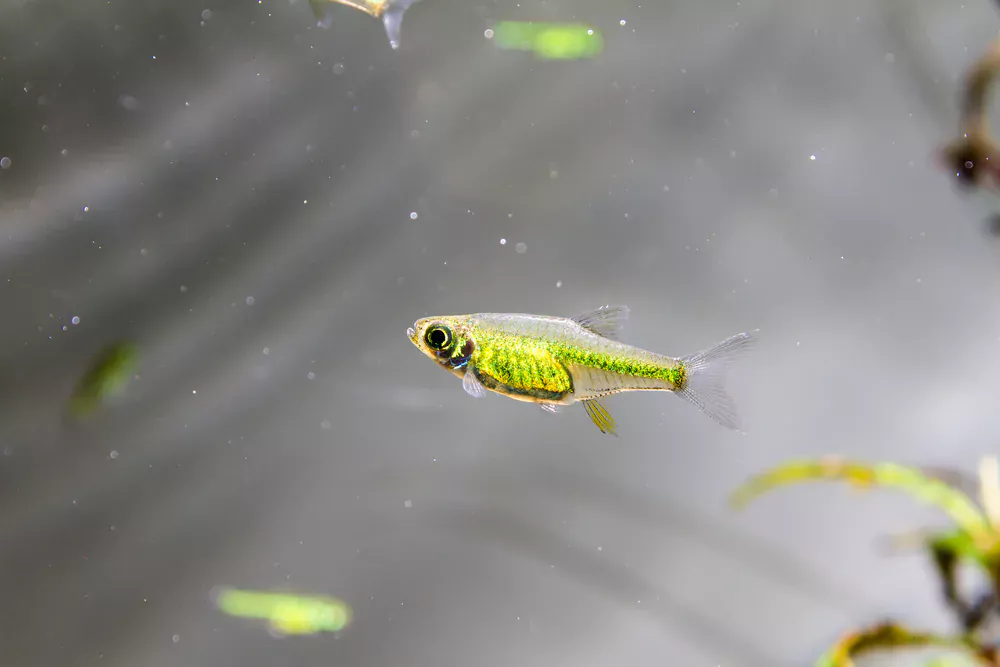Neon green rasboras also known as Kubotai rasboras are a type of freshwater fish that have been popular for a long time now. It’s good to know more about what you’re getting into before you make your purchase, and there are a few things that are good to know before you buy one of these beautiful small fish.
In this article, we’ll discuss all those things and with a few facts about neon green rasboras that you should know before you buy one!
- 1 Neon Green Rasbora Lifespan
- 2 Neon Green Rasbora Size
- 3 Neon Green Rasbora Temperature
- 4 Neon Green Rasbora Tank Mates
- 5 Neon Green Rasbora Tank Size
- 6 Is Neon Green Rasbora Schooling Fish? If So, What’s the Best School Size?
- 7 Neon Green Rasbora Breeding Guide
- 8 Neon Green Rasbora Care
- 9 Best Neon Green Rasbora Food
- 10 Common Neon Green Rasbora Diseases
- 11 Is Neon Green Rasbora For Sale?
- 12 Few Final Things
Neon Green Rasbora Lifespan
Neon green rasboras live between 3 and 5 years on average. They can sometimes live as long as 6-7 years given the right conditions. In captivity, they are usually sold at 4-5 months old and sometimes even younger. Their lifespan may be shorter due to poor health conditions when they are sold at the store.
To maximize the lifespan of your neon green rasbora, find a healthy stock for a longer lifespan.
Neon Green Rasbora Size
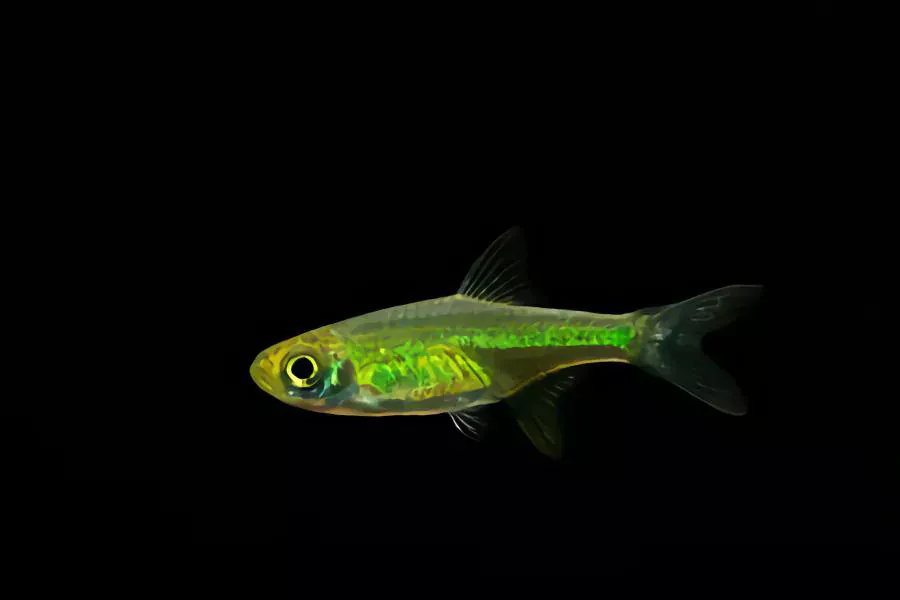
Neon Green Rasboras are relatively small in size growing to an average length of 2 inches (5 cm). They are a very flat and slim-looking small fish with the males being slightly larger than the females.
Neon Green Rasboras have a straw-colored body with a bright neon green stripe running down their back. The underside of this small fish is white and the tail fin is translucent. Their dorsal and anal fins are tipped with red.
Neon Green Rasbora Temperature
The best temperature for neon green rasbora is around 75 to 80 degrees Fahrenheit. This is because neon green rasbora is tropical small pet fish. They prefer warmer water temperatures and will not do well in colder water.
Neon Green Rasbora Tank Mates
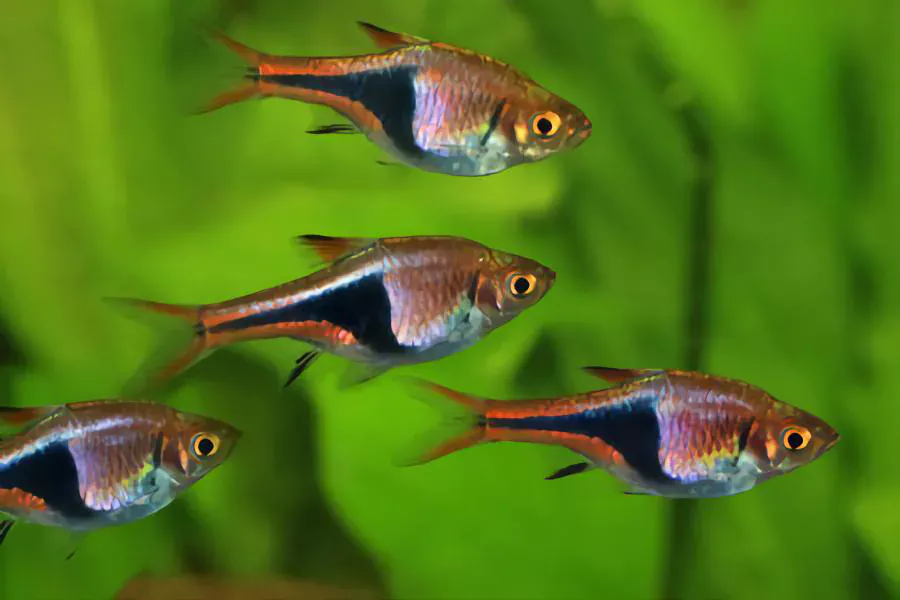
While the Neon Green Rasbora is a peaceful pet fish, it can still be quite aggressive when it comes to food. This means that it should only be kept with other peaceful and smaller fish species, especially those that inhabit the same water column.
Ideal neon green rasbora tank mates include:
- Harlequin Rasboras
- Celestial Pearl Danios
- Pygmy Corydoras
- Dwarf Pencilfish
- Ember Tetras
- Rosy Barbs
- Kuhli Loaches
Neon Green Rasbora Tank Size
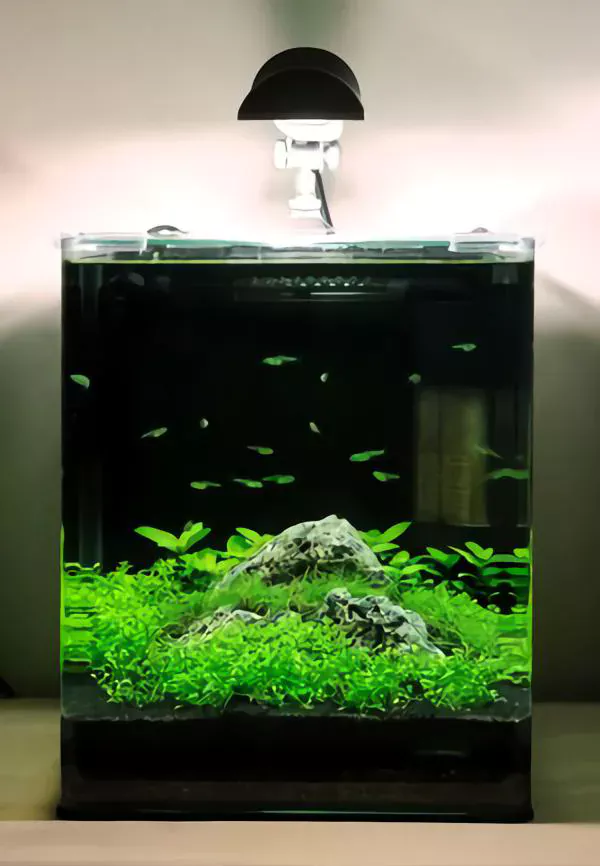
As with most of the smaller pet fish species, a school of kubotai rasboras can be kept in a smaller fish tank. The minimum fish tank size is 15 to 17 gallons. More space will allow the fish to live longer and stay healthier. It’s also recommended to include plenty of plants in the aquarium which will provide hiding places for the shy rasboras.
The Neon Green Rasbora prefers well-planted fish tanks with rocks, driftwood, and cave-like structures for hiding places and territories. The fish are most active during daylight hours when they will swim in large schools throughout the aquarium. They prefer subdued lighting.
The only real drawback of keeping these fish is having to keep them in a school of at least 6 or 8 individuals. They prefer being kept in a larger group and can become stressed if kept alone or with just one or two other fish. However, if you have plenty of room for a larger tank and want to keep these beautiful little rasboras, it shouldn’t be too much of an issue.
Is Neon Green Rasbora Schooling Fish? If So, What’s the Best School Size?
Neon rasboras are schooling fish as I mentioned earlier. It is best to keep them in groups of at least 6-8 individuals or more. This reduces stress and makes them feel secure in the tank. They will be most active and playful when kept in a large group.
Neon Green Rasbora Breeding Guide
As you know, The Neon Green Rasbora has a relatively short life span of 3-5 years. When they reach breeding age they will mate with each other, but this is not always successful due to their small size. To give them the best chance at mating successfully, you should have at least 6 (and more than 10 would be ideal) in one tank. They prefer soft water and a slightly acidic pH level between 6.0 and 7.0.
When it comes time for breeding, it’s best to move the adult fish into a separate tank for breeding purposes and then move them back into the community tank once they have laid their eggs and fertilized them. The newborn pet fish will grow quickly as long as they are being fed properly and they will reach maturity in just 6 months.
You need to make sure that you have a breeding tank prepared for them, especially if you want the fry to survive. When it comes to feeding the fry, it can be quite difficult as they are so small and will need some pretty small food items.
Neon Green Rasbora Care
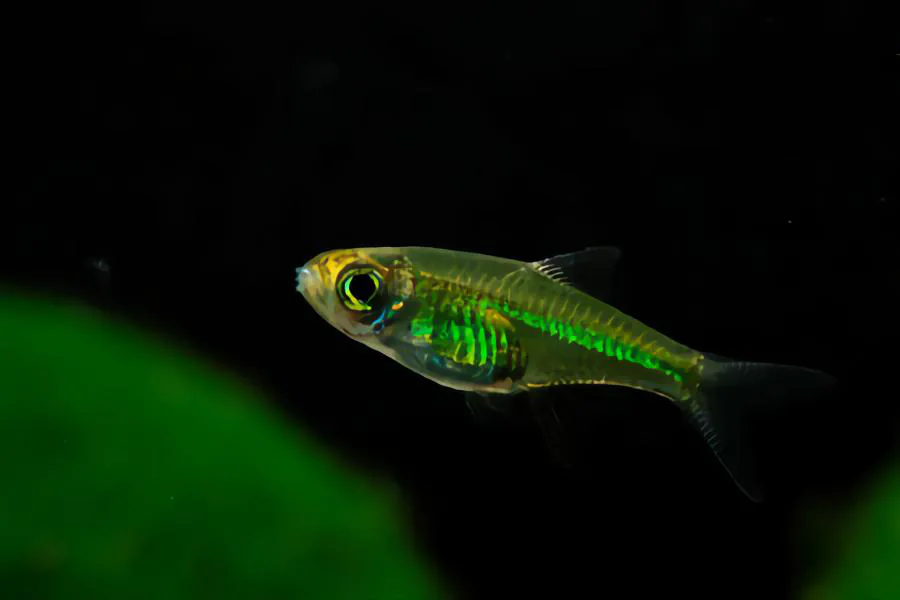
The minimum recommended size for an aquarium housing neon green rasboras is 15 gallons (56 liters). The fish have a relatively large bio-load for their size, so you need to make sure there is enough water and filtration to accommodate them. They are active swimmers, so the aquarium needs to belong and be at least moderately tall.
The preferred pH level for the neon green rasbora is soft to medium acidity between 6.0 and 7.0 as mentioned earlier; however, these hardy pet fish can tolerate variations in pH levels if they are introduced properly. Similarly, they can tolerate temperatures between 75 and 80 F (22 – 28 C).
The Neon Green Rasbora is best kept in a planted aquarium with plenty of open swimming space and hiding places amongst plants and driftwood roots or branches. It is best to keep them in a tank with soft, slightly acidic water with the above-mentioned pH level. The addition of dried leaf litter would further emphasize the natural feel and as well as offering additional cover for these timid pet fish. A few floating plants to diffuse the light entering the aquarium can also be added.
Best Neon Green Rasbora Food
Feeding is an important part of keeping fish. In order to keep your kubotai neon green rasboras healthy, it is important that you feed them the correct types of food.
Neon Green Rasbora, like most fish, are primarily omnivorous. This means that they eat both plants and other animals. In the wild, they feed on zooplankton, insect larvae, other small invertebrates, and plants. In captivity, it’s important to feed them a varied diet in order to promote good health, coloration, and reproduction.
Selecting the best neon green rasbora food might be challenging as you have to filter through a large number of identical products available on the market. Don’t worry though; we have got our hands on 5 trendy and top-rated products and below is our recommendation.
Best Neon Green Rasbora Food
- API Tropical Fish Food Flake
- TetraMin Plus Tropical Flakes
- Hikari Tropical Micro Pellets
- API Tropical Fish Food Pellet
- Tetra Pro Color Tropical Flakes
Common Neon Green Rasbora Diseases
Unfortunately, Neon green rasboras are susceptible to certain diseases that can make life in an aquarium difficult and even cause death. Being aware of these diseases will help you ensure that your fish live long and happy lives.
These are the few common neon green rasbora diseases:
1- Ich
The most common disease affecting the neon green rasbora is Ich. This disease is caused by a parasite known as Ichthyophthirius multifiliis, which attaches itself to the rasbora’s body and causes small white spots. The disease can spread rapidly through an aquarium, causing stress for all of the fish in it. If left untreated, many of the fish will die from this disease. Ich is usually treated with salt baths or medication. However, you must be careful not to overmedicate your tank as this can also kill your fish.
2- Fin Rot
Another common disease that affects the neon green rasbora is fin rot. This disease causes the fins of the fish to rot away, leaving them stubby or completely missing in extreme cases. Fin rot occurs when bacteria enter into a break or wound on a fish’s fin.
3- Columnaris Disease
Columnaris is one of the most common bacterial infections that affect neon green rasboras. This disease usually infects fish that are stressed, injured, or weak. The bacteria causing this disease live on the skin and gills of healthy fish but they do not cause any harm to them. However, if these bacteria enter the open wounds they multiply rapidly and start attacking tissues around the wound. The symptoms of this disease include grey patches on the skin, frayed fins, and ulcerations on the body.
4- Neon Tetra Disease
This is caused by a parasite that affects the intestines of your fish. It is easily cured with medication. If left untreated though it can be fatal to your fish.
5- Fungus
This usually occurs as a secondary infection and will appear as white patches on the skin of your fish. Treat with medication if you see this occurring in your tank.
Note: Always consult the specialist before giving any medication to your fish.
Is Neon Green Rasbora For Sale?
Yes, You should be able to find neon green rasbora at most any pet store that sells tropical fish. Many of these stores will allow you to purchase just one or two fish at a time, which is great if you only want a few. If you live near a large city, you may have access to many different pet stores and be able to shop around for prices.
kubotai rasboras are also available online through online retailers such as eBay or Amazon. It is important to note that the shipping costs can make this an expensive option, but it is a good option if your area does not have any brick-and-mortar retailers nearby.
When you buy your rasbora, it’s important to make sure that they are healthy. This means that they have bright colors and clear eyes. They should also be active and responsive to their environment.
An adult rasbora is about 2-3 inches long. When you buy one, keep in mind that they will grow larger with time.
Few Final Things
The Neon Green Rasbora is a colorful pet fish that can be kept as a pet. If cared for properly, it can have a pretty decent lifespan. It enjoys being in groups and likes having a lot of plants in its tank.
It’s important for its environment to match the pH level and temperature of its natural habitat (the peat swamps of Malaysia, Brunei, and Borneo).
Let Please let me know in the comment if you have any questions.

